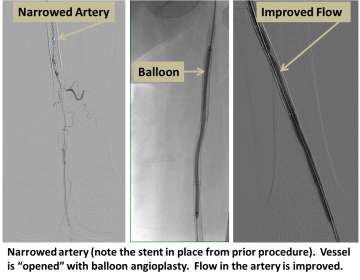Angioplasty and Vascular Stenting
Find your care
Our board-certified physicians diagnose and treat many vascular conditions. Call 310-481-7545 to learn more about interventional radiology services.
Treatment for:
PAD (peripheral arterial disease), narrowing or blockage of the arteries supplying the arms and legs
Why it’s done:
Atherosclerosis causes narrowing or blockage of the arteries supplying the legs, or more rarely, the arms. Blockages of these arteries can cause claudication (pain with walking), rest pain (pain occurring at rest), or tissue loss (gangrene or an open wound, usually on the foot or ankle). Opening these blockages and restoring blood flow can reverse these problems.
How it’s done:
The artery is accessed with a small puncture, and the area of blockage is crossed using specialized wires and catheters. The blockage is then opened using balloon inflation (angioplasty), flexible metallic tubes (stents), or by directly removing the atherosclerotic plaque (atherectomy).

Level of anesthesia:
Conscious sedation
Risks:
Bleeding, infection, damage to the artery wall (rupture or dissection). Clot or plaque can break off during the intervention and pass down toward the foot, limiting flow (distal embolization). In most cases, these complications can be recognized and treated during the procedure. Rarely, open surgery or even amputation may be required.
Post-procedure:
Several hours of lying flat, then discharge home. Anticoagulation or anti-platelet agents may be used to help keep the treated arteries open.
Follow-up:
Doppler ultrasound and clinic visit is typically performed several weeks after the procedure to confirm that the artery remains open and that symptoms have improved. Continued follow-up depends on the individual case.
For More Information:
For more information or to schedule an appointment with one of our IR physicians, please call 310-481-7545.